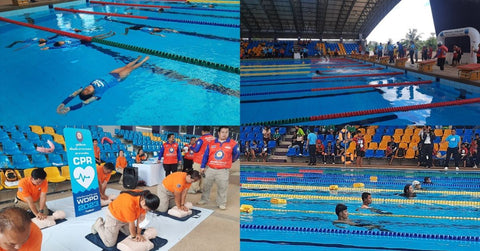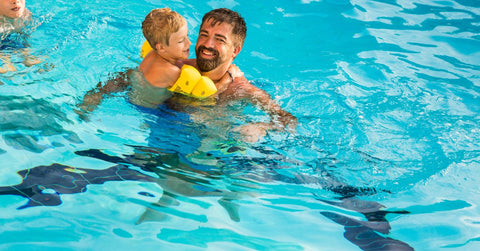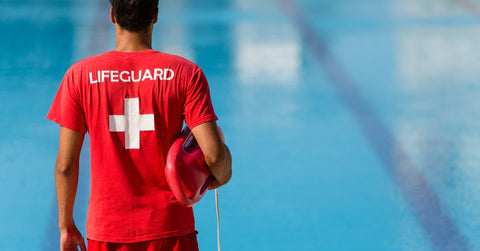A Deep Dive into Thailand's Efforts and Challenges to prevent drowning
Thailand's breathtaking landscapes, pristine beaches, and meandering rivers have long been a source of pride and a magnet for tourists. Yet, beneath the surface of these picturesque waters lies a hidden tragedy: drowning.
Every day in Thailand, 10 people die from drowning on average, or around 3,600 people per year. Whether it's children playing by the riverbanks, tourists enjoying the beaches, or fishermen at work, anyone can fall victim to drowning. It's not just a coastal concern; it affects communities across Thailand, from bustling urban areas to remote villages.
Drowning is a threat that demands immediate attention and collective action. In this article, we explore the urgent need for drowning prevention and highlight how lifeguard and First Aid CPR training can be instrumental in saving lives.
Drowning is the leading cause of death among Thai children under age 11

Drowning often happens silently and swiftly, catching victims and bystanders off guard. Drowning—this silent threat lurking beneath the surface—has a particularly significant impact on children.
Hence, from 2000 to 2018, there have been nearly 1,300 child drowning cases recorded per year. The Department of Disease Control, Ministry of Public Health, reported that drowning stands as the primary cause of mortality among children aged 1 to 11 years old and the second leading cause of death for children under 15 in Thailand, accounting for a staggering 20% of all deaths in this age group.
These alarming statistics may come as no surprise, given a certain lack of adequate laws, policies, and infrastructure to enhance swimming skills, supervision, and rescue operations at this time. As an example, Thailand still lacks specific laws that mandate schools to offer swimming lessons and private companies to provide certified lifeguards at supervised swimming pools, lakes, rivers, or beaches.
The Global Call for Drowning Prevention since 2015

Thailand has responded to this critical situation by forging a collaborative alliance among ten vital sectors. These sectors encompass healthcare, education, law enforcement, disaster risk management, maritime safety, non-governmental organizations like the WHO, local administration, tourism, the Royal Thai Navy, and the National Institute for Emergency Medicine. Each sector fulfills a unique role, collectively contributing to a comprehensive approach aimed at addressing the issue.
A significant initiative in Thailand's arsenal against drowning is the "Merit Maker for Child Drowning Prevention" strategy, initiated in 2015. This strategy places a strong emphasis on reducing child drownings through initiatives such as child supervision, water safety education, safety measure implementation, and the promotion of public awareness about the risks associated with drowning.
Hence, increased public awareness and the inclusion of more children in swimming programs have gradually diminished the number of fatalities over the past 5 years in Thailand. According to the WHO, around 737 children aged under 15 died from drowning in 2021. This is a 50% reduction in child drowning fatalities over a five-year period (1,300 child drownings in 2018).
Join the Movement to Save Lives

Hence, the prevention of drowning and the saving of more lives in Thailand continue to be shared endeavors worth pursuing. And as individuals, we can all contribute to this vital cause by:
1. Promoting Water Safety: Educate yourself and your loved ones about basic water safety measures, including swimming skills, the importance of life jackets, and how to recognize potential drowning risks.
2. Supervising Children: Never leave children unattended near water, whether it's a pool, river, or bathtub. Keep a watchful eye on children and inexperienced swimmers when near water. Drowning can happen in seconds.
3. Promoting Swimming Lessons: Encourage swimming lessons for children and adults alike. Learning to swim is a valuable life skill.
4. Supporting Drowning Prevention Initiatives: Support organizations and initiatives focused on drowning prevention and water safety awareness. Organizations like Bangkok First Aid (bangkokfirstaid.com) offer training and resources for drowning prevention and response. Supporting these initiatives can make a significant difference.
5. Learning First Aid and CPR: Enroll in a first aid and CPR course to acquire the skills needed to respond effectively in aquatic emergencies.
6. Becoming a Lifeguard: Certified lifeguards are trained to recognize and respond swiftly to potential drowning incidents, effectively rescuing and providing immediate care to victims. By preventing and responding to emergencies, lifeguards play a pivotal role in reducing drowning incidents and raising awareness about drowning prevention in Thailand.
The Power of Lifeguard, First Aid and CPR Training

When it comes to drowning prevention, knowledge is a lifesaver. Lifeguard, first aid and CPR training play a pivotal role in equipping individuals with the skills needed to respond effectively in aquatic emergencies. Here's how:
1. Quick Response: Knowing what to do in the critical moments after a drowning incident can mean the difference between life and death. Lifeguard, First aid and CPR training teach individuals how to assess the situation, provide immediate care, and initiate rescue efforts.
2. Confidence to Act: Training instills confidence, enabling bystanders to step in and assist until professional help arrives. In cases of drowning, seconds count, and a trained responder can make all the difference.
3. Prevention Through Education: Lifeguard, CPR, and first aid courses also emphasize the importance of water safety and drowning prevention measures. Education can help reduce the risks associated with aquatic activities.
Conclusion
Drowning is a preventable tragedy that affects families and communities across Thailand. By raising awareness, taking proactive steps, promoting swimming lessons, and providing first aid and CPR training, we can make significant strides in reducing the devastating impact of drowning. Let's heed the global call to action and turn it into a local commitment to save lives and create safer aquatic environments in Thailand.
Join us in the mission to save lives. We encourage you to participate in our Lifeguard, First aid and CPR training programs to enhance aquatic safety standards. Together, we can make a difference and protect our loved ones from the silent threat of drowning.



